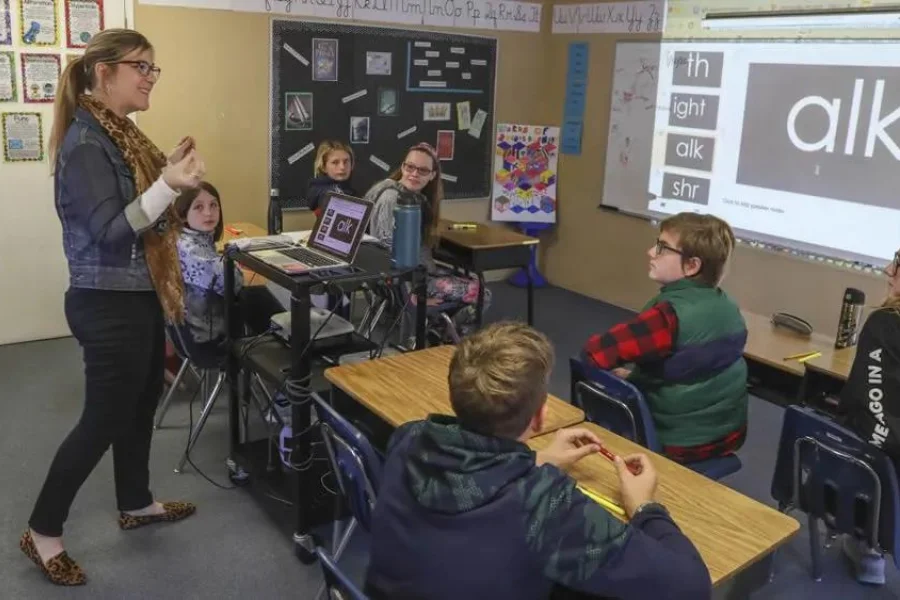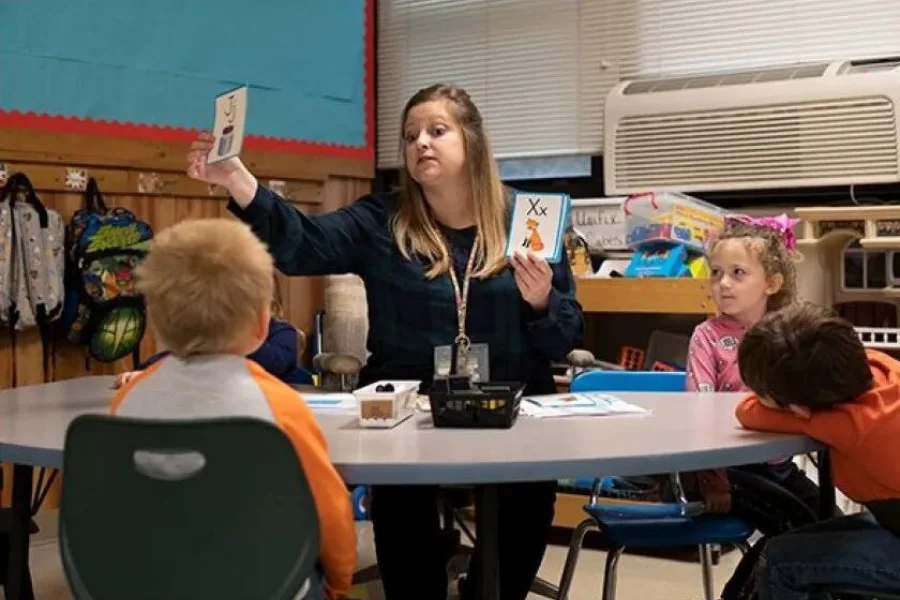Types of Phonics

Source: landmark
Types of Phonics
Considering and assessing the different Types of Phonics is essential for anyone looking to enhance reading and writing skills to build a teaching career. Phonics- the method of teaching reading by associating sounds with characters in an alphabetic writing system, comes in various forms. Different Types of Phonics give unique approaches to learning, providing different learning styles and needs. Whether it’s synthetic phonics, which focuses on sounding out letters to form words, or analytic phonics, where students learn to analyze letter-sound relationships in before-learned words, these Types of Phonics provide foundational abilities for literacy.
The voyage into reading is both exciting and intricate, with phonics acting as the guiding star. Phonics, the method of teaching reading and writing by connecting sounds with symbols in an alphabetic writing scheme, has various types, each essential in its approach to literacy. This blog goals to lighten the Types of Phonics, providing visions into their features and applications.
Table of Content

Source: brightspotcdn
Synthetic Phonics
Definition and Approach
In Synthetic Phonics, the children are trained to articulate individual sounds (phonemes) separately and then blend them to make words. It is an organized type that makes it unique from the other Types of Phonics and often starts with simpler sounds, continuing to more intricate sound mixtures.
Example
For instance, in learning the word ‘flash’, students first sound out /f/, /l/, /a/, /sh/ and then blend these to say ‘flash’.
Application
This method is effective for early readers, building a solid foundation for decoding new words independently.
Analytic Phonics
Definition and Approach
Analytic Phonics takes a more holistic approach. Instead of sounding out letters individually, students learn to analyze whole words to detect phonemic patterns. As compared to other Types of Phonics, this type is less focused on individual phoneme sounds and more on larger units within words.
Example
Considering the word ‘strong’, a teacher might help students identify the /str/ blend by comparing it with ‘street’ or ‘stride’.
Application
This practice is perfect for children who have previously started reading and are increasing their word stock.
Call +919869866277 / +919869546913 to be a part of the outstanding Phonics Teacher Training Course!
Clicking here will help you download the brochure of the Phonics Teacher Training Course.
Embedded Phonics
Definition and Approach
Embedded Phonics is integrated into text reading. This incidental, less systematic approach emphasizes learning phonics skills within the context of literature.
Example
During a reading session, when coming across the word ‘magic’, a teacher might discuss the /g/ sound made by ‘g’ in this context.
Application
This approach is beneficial in making phonics learning more relevant and engaging, as it is connected with actual reading experiences.
Analogy Phonics
Definition and Approach
In Analogy Phonics, learners use their knowledge of phonograms to understand new words. It involves teaching students to use familiar word parts (like -at in ‘cat’) to read and decode unfamiliar words.
Example
A student familiar with ‘cake’ can apply this knowledge to decode ‘bake’ or ‘fake’.
Application
This method is particularly useful for helping children decode longer, more complex words.

Source: brightspot
Phonics through Spelling
Definition and Approach
This approach ties in phonics learning with spelling. It emphasizes understanding the correspondence between phonemes and graphemes and how this relationship governs spelling.
Example
Teaching how to spell ‘ship’ would involve understanding how /sh/, /i/, and /p/ come together.
Application
Phonics through Spelling is excellent for reinforcing both reading and writing skills, making it a dual-purpose approach.
Multisensory Phonics
Definition and Approach
Multisensory Phonics includes visual, auditory, and kinaesthetic learning methods to teach phonics. It’s specifically helpful for students with various learning styles or those with learning problems.
Example
This could involve using finger painting to form letters or creating letter shapes with clay.
Application
Multisensory Phonics is ultimate for involving multiple senses, assisting memory, and making learning more dynamic and interactive.
By knowing these Types of Phonics, teachers and parents can be involved in more effective strategies made according to the individual needs of students. These different Types of Phonics offer unique benefits, and a blended approach usually gives the best results. Understanding and mastering the Types of Phonics not only helps develop reading skills but also guides every child to discover and fall in love with the world of words!
Call +919869866277 / +919869546913 to be a part of the outstanding Phonics Teacher Training Course!
Clicking here will help you download the brochure of the Phonics Teacher Training Course.

Source: bridge
Phonics Teaching Course
The significance of phonics cannot be overstated in the continuously evolving realm of language education. To overcome this need, the Phonics Teaching Course presented by Vidhyanidhi Education Society (VES) stands as an ocean of knowledge for aspiring teachers. This course is exactly designed to provide teachers with an understanding of different Types of Phonics and essential skills to effectively teach phonics.
Here’s a detailed look at what this course provides:
24 Hours of Intensive Training
The Phonics Teaching Course includes an intensive 24-hour training program.
This intensive training makes sure that teachers are thoroughly prepared to teach phonics with confidence and proficiency.
Each session is crafted to increase understanding and practical application of phonics in educational settings.
UK-based Synthetic Phonics Teaching Methodology
From the different Types of Phonics, this course follows the renowned UK-based Synthetic Phonics Teaching and Learning Methodology.
This approach is broadly renowned for its effectiveness in teaching reading and writing.
It highlights the connection between sounds (phonemes) and their consistent letter patterns (graphemes), a key feature in the Types of Phonics.
Audio-Visual Teaching Aids
To increase the learning practice, the course provides lectures that use audio-visual teaching aids.
This modern approach to teaching not only makes the learning process more interactive but also provides various learning styles, making the understanding of phonics more available and effective.
Sounds Demonstration with Jingles, Stories, and Actions
An innovative feature of the Phonics Teaching Course is the demonstration of sounds through jingles, stories, and actions.
This creative method aids in memorizing and understanding the different sounds, making the learning process fun and interactive.
Practice 42 Sounds
An important element of the course is the in-depth practice of all 42 sounds, which consists of both letter sounds and digraphs.
This full practice makes sure that teachers have been provided well to teach every part of phonics, bringing into line with the various Types of Phonics approaches.
Mock-drills
The course includes mock drills, providing a hands-on experience in phonics teaching.
These drills are designed to simulate real classroom scenarios, giving educators a practical understanding of how to apply their knowledge effectively.
Doubt-Solving and Question-Answer Sessions
To make sure that a broad consideration of the course material, there are dedicated doubt-solving and question-answer sessions.
These sessions allow teachers to clear any doubts and problems gaining deeper visions into the details of phonics teaching.
The Phonics Teaching Course offered by Vidhyanidhi Education Society is a precisely organized program, perfect for those who are keen to understand the Types of Phonics and master the art of teaching phonics. By covering a broad range of teaching techniques and making sure of thorough practice, this course stands as a valuable resource for teachers who want to shine in the field of phonics education.
Types of Phonics
Join Vidhyanidhi’s Phonics Course – Elevate your teaching journey today!
Call +919869866277 / +919869546913 to be a part of the outstanding Phonics Teacher Training Course!
Clicking here will help you download the brochure of the Phonics Teacher Training Course.
FAQs
How to become a Certified Phonics Teacher?
To become a Certified Phonics Teacher, complete a known phonics training course and take hands-on teaching practice.
What is Duration of Phonics Course for Teachers?
The length of a Phonics Course for Teachers usually ranges from 20 to 40 hours, differing by program and strength.
Can I do Phonics Teacher Training Course Online?
Yes, you can undertake Phonics Teacher Training Course online offering flexibility and access to digital resources.




